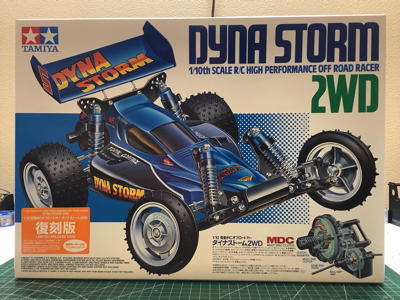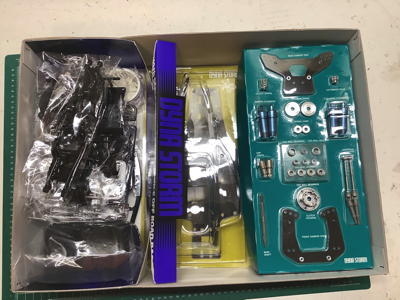Tamiya Dyna Storm Project
Page 1: Building the Chassis
That orange sticker on the box identifies this as the re-release version
of the Dyna Storm. Other than that, it looks exactly like the
original. Because the original didn't come with a motor, there is
no space in the blister packs for the pink motor that came with the
re-re. This is a proper old school box with a full visual
presentation of all the key parts of this chassis. Because the
body doesn't have an overspray film, you can see through it to the
center blister pack.
Here I'm showing the contents of the blister packs and some other
special parts. The cyan blister contains the FRP shock towers,
aluminum shock bodies, universal axles, and the clutch housing.
The mustard blister contains the FRP chassis plate and brace. The
right hand photo also shows the metal motor mount and battery holder.
There is a lot of hardware in this model as you can see. I
needed 8 servo bins to contain it all. I love this kind of build:
very complex with lots of parts. Note that full ball bearings are
included on the far right.
This picture shows the full contents of the box attributable to the
chassis on my build table, ready to get started. There's something
special about the old manuals with the blue printing.
The build starts with the main chassis plate which is FRP (fiber
reinforced plastic). While the plate is already very stiff, the
addition of the plastic side plates shown really makes the whole thing
incredibly rigid. The view from below shows that 4 screws were
used per side to affix the stiffeners. They are not
symmetric. One has a bump to make room for the servo corner.
A C-shaped bracket is installed next to support the battery, but this
also serves to add even more rigidity to the chassis. The front
bumper and skid plate also install at this point.
Next comes the dual bellcrank steering. The steering links are
turnbuckles which allows for easy toe adjustment. These look like
they might be titanium, but I'm not 100% sure. If only I had a
mass spectrometer. The only bushings (as opposed to bearings) used
in the model support the steering cranks, but I'm OK with this.
They only need to support small rotations.
Next comes the assembly of the steering uprights and knuckles. A
completed assembly is compared to an exploded view on the left.
The upright is a C-hub and the knuckle is a plastic crank with a steel
axle pressed into it. The kingpin is a smooth shaft with E-clips
at either end. On the right I've assembled the front shock tower
to the upper suspension links which are also turnbuckles. Note the
flanged bushings which will support the lower control arm pivots.
The lower arms are now connected to the front suspension block with
smooth pins as shown on the left. The steering knuckles are also
attached. Note the unique, complex shape of the lower arms.
In the exploded view, the wrong arm is actually shown. I set a
rear arm on the table for the picture but it should of course be a front
arm similar to the one already installed. On the right the front
suspension module has been attached to the chassis plate.
Here is the rear lower suspension assembly. Again we see the
complex arm geometry. The arms are separated by a metal plate and
pivot on flanged bushings supported by plastic brackets. The
assembly is shown attached to the chassis on the right. The
installation uses the fairly uncommon Tamiya press nuts (no hex,
friction fit).
Now to build the rear ball differential. At this point these are
pretty standard for me, but I always enjoy the process. There are
ten 3mm balls in the ring gear and nine Belleville washers under the
thrust bearing which have to be stacked in a specific orientation.
The pressure disks are aluminum with a steel contact ring and are
splined on the inside to accept the drive cups.
Here is the completed ball differential alongside the other two gears
which make up the inside of the transmission. The assembly is
shown at right. The counter gear is supported by a hollow axle
shaft, and the drive gear splines to the main shaft.
Here is the transmission with both housings fastened. On the right
you can see the metal motor mount has been attached as well as the FRP
support brace.
Although 0.4 mod gears (metric) and 64p gears (imperial) are considered
to be compatible, they are not exactly the same. 0.4 mod would
technically be equivalent to 63.5p. This is the first kit I've
ever seen which comes with a spur gear for each option. They both
have 126 teeth and are barely distinguishable, but the 64p has a very
slightly larger diameter. Even though it is much easier to source
64p pinions where I live, I decided to stick with the 0.4 mod spur and
use a Tamiya pinion to keep it all in the family. This is a very
fine pitch which is unusual for Tamiya buggies. It offers a lot of
pinion size options as well as very quiet running.
Now to build the MDC (Multi-Disk Clutch), one of the defining features
of the Dyna Storm. It builds up very similarly to a motorcycle
clutch. The input shaft has flats on it which mate with the four
pressure disks on their inner diameter. The three clutch disks are
made of a friction material and mate with the housing on their outer
diameter. The housing is bolted to the spur gear. In the
absence of any clamping force, no torque is transferred from the spur
gear to the input shaft. Pressure on the coil spring provides
friction to clamp the rotors and stators together while still allowing
slippage if a certain torque threshold is exceeded. Using multiple
disks allows for a much smaller diameter clutch than a standard single
disk clutch. Slipper clutches are unusual on Tamiya vehicles, so
this one is a big deal. The parts are shown on the left and the
open assembly on the right.
Here I've installed the spring to adjust the preload on the
clutch. That completes the gearbox allowing the whole thing to be
bolted to the rear of the chassis as shown on the right.
Here are the subassemblies for the battery hold down bracket and the
rear shock tower. The bracket is sheet metal with an FRP plate
beneath. The shock tower is also FRP and supports the bracket
which will hold the rear wing.
Now I've installed the bearings and universal axles into the rear
uprights. The universals are pre-assembled and are intended to be
permanent. The right hand photo shows the completed rear
suspension with uprights and upper turnbuckles installed.
These beautiful shocks are unique to this model. They are the only
Tamiya shock set to use a sleeved insert. The intent is to reduce
friction and wear, but of course it also reduces fluid volume.
The piston head rides against the sleeve. The head and rod end
caps are also aluminum and there are plenty of seals. All four
dampers use the same cylinders and rods, but the front dampers have an
internal spacer to limit the extended length. The rear springs are
also stiffer.
Now I tried installing the stock pink motor and the stock pinion to see
how it drove and compare it to the Acto Power motor. On the right
I've also added the MDC cover plate which still allows access to make
adjustments.
The final rolling chassis is shown on the left. You can see that
I've installed the upper FRP chassis
stiffener and the steering servo. The wheels are common enough,
but the rear tires with the round spikes are rare as are the front
ribbed tires. I don't intend to run on these tires; I'll use a
more common set. There is not much room for
electronics as you can see on the right. At this point I had not
yet installed the final power system, but I chose an 80A ESC to handle
the low turn motor and changed the connector to use a 2s LiPo.
Unlike the original Dyna Storm which came with no motor, the re-release
came with a pink motor similar to, but distinct from the pink Acto-Power
motor recommended for the original. The kit motor has no specs
published for it, but it is generally considered that the original 14T
pink motor is better so I picked one up. You can see the
differences on the left. The motor with the label is older and is
the one I used. One subtle difference is the the green and yellow
wires are opposite when comparing the motors, yet they still rotate the
same direction when connected to color-coded power. Another
difference is that the kit motor does not have adjustable timing but the
Acto Power does. I set it to full advance which actually required
me to set the timing the opposite direction from how I received
it. The motor was set to retard the timing out of the box.
Odd. I used the kit
recommended 24T 0.4 Mod steel pinion gear shown.
©2021 Eric Albrecht

